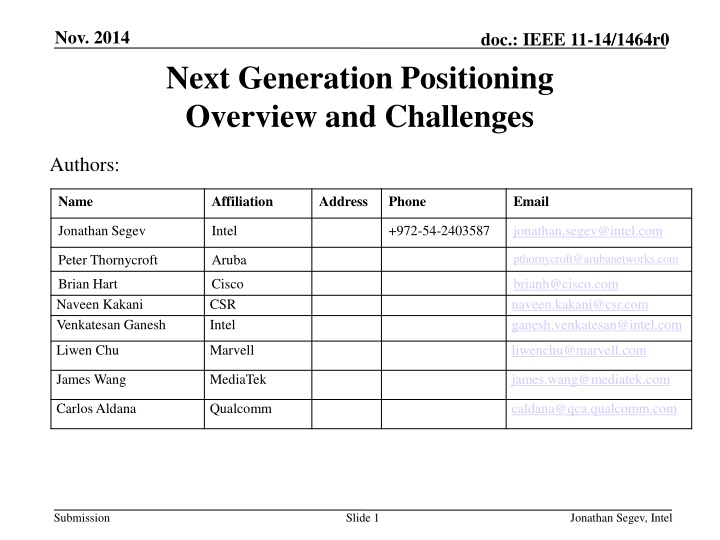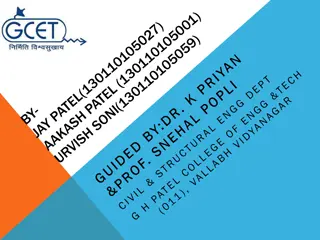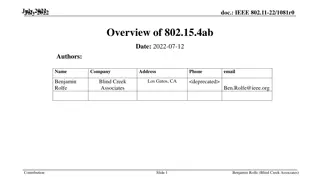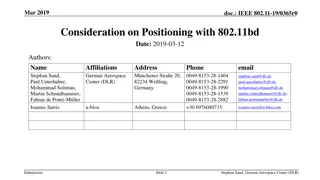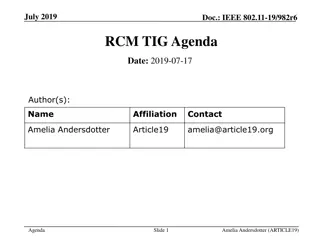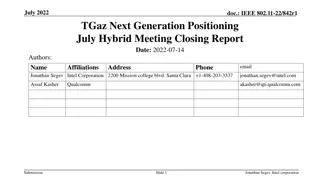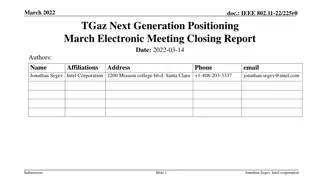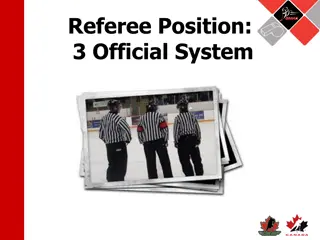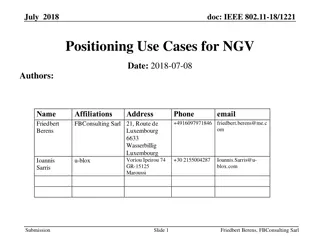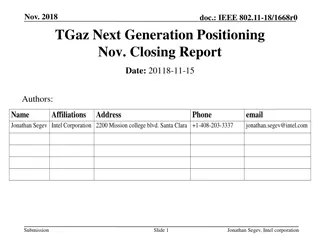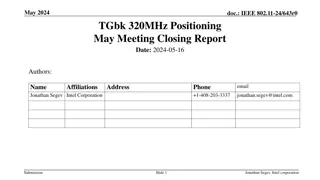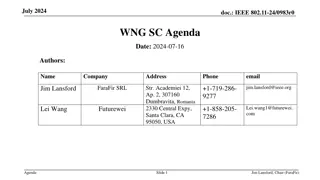IEEE 11-14/1464r0 Next Generation Positioning Overview and Challenges
This document discusses the challenges and overview of enabling commercial positioning models for 802.11 based positioning. It emphasizes the symbiotic relationship between data connectivity and positioning services, especially focusing on the advantages of utilizing 802.11 WLAN technology for indoor positioning approaches like fingerprinting. The document also delves into the importance of contextual information for positioning and the benefits of reusing existing technology for developing positioning services.
Download Presentation

Please find below an Image/Link to download the presentation.
The content on the website is provided AS IS for your information and personal use only. It may not be sold, licensed, or shared on other websites without obtaining consent from the author.If you encounter any issues during the download, it is possible that the publisher has removed the file from their server.
You are allowed to download the files provided on this website for personal or commercial use, subject to the condition that they are used lawfully. All files are the property of their respective owners.
The content on the website is provided AS IS for your information and personal use only. It may not be sold, licensed, or shared on other websites without obtaining consent from the author.
E N D
Presentation Transcript
Nov. 2014 doc.: IEEE 11-14/1464r0 Next Generation Positioning Overview and Challenges Authors: Name Affiliation Address Phone Email Jonathan Segev Intel +972-54-2403587 jonathan.segev@intel.com pthornycroft@arubanetworks.com Peter Thornycroft Aruba Brian Hart Naveen Kakani Venkatesan Ganesh Cisco CSR Intel brianh@cisco.com naveen.kakani@csr.com ganesh.venkatesan@intel.com Liwen Chu Marvell liwenchu@marvell.com James Wang MediaTek james.wang@mediatek.com Carlos Aldana Qualcomm caldana@qca.qualcomm.com Submission Slide 1 Jonathan Segev, Intel
Nov. 2014 doc.: IEEE 11-14/1464r0 Motivation and purpose In previous contributions several useful usage models that are of commercial use for positioning have been presented. This contribution presents some of the challenges in enabling this set of usages for 802.11 based positioning and an overview of positioning techniques. Submission Slide 2 Jonathan Segev, Intel
Nov. 2014 doc.: IEEE 11-14/1464r0 Why 802.11 Based Positioning? Positioning has symbiotic relation with data connectivity: Positioning means nothing without contextual information. Data connectivity improves with the addition of positioning. 802.11 based WLAN is almost ubiquitous in many indoor environments (malls, retail chains). Building on existing technology enables reuse: Many of the use cases revolve around the smartphone (already packed with radios, reuse keeps complexity of actual device in check). Reuse of connectivity technology shortens and simplifies technology development. Symbiotic relationship between data and positioning services Submission Slide 3 Jonathan Segev, Intel
Nov. 2014 doc.: IEEE 11-14/1464r0 What is 802.11 Based Positioning? Indoor positioning major approaches: Fingerprinting a unique characteristic of the radio signal(s). Example: identify a position based on a set of RSSIs associated with APs. Geometrical a mathematical model of the signal propagation properties is created. A device uses this model to trilaterate/multilaterate/triangulate its position using measurements to derive its position. Submission Slide 4 Jonathan Segev, Intel
Nov. 2014 doc.: IEEE 11-14/1464r0 Positioning approaches - Fingerprinting A survey of the site is performed and fingerprint of the signals properties are taken; alternatively crowd sourcing might be used. Example: A device takes measurements and sends it to server. The server performs pattern matching trying to find the best matched position. Submission Slide 5 Jonathan Segev, Intel
Nov. 2014 doc.: IEEE 11-14/1464r0 Positioning approaches Fingerprinting Essentially any positioning technique can be used with fingerprinting, however RSSI fingerprinting variant is most suited (Rx only, AP scan already part of API). Accuracy improves as range to AP reduces. RSSI example: Pro s Con s Simple to implement. Sensitive to noise and channel variations. Easy to crowd source. Less dynamic. No need for a known AP location Not well suited for proximity usages. Minimal/no impact on medium usage. Changes in the environment requires many DB updates. Geopriv is easy to achieve with downlink RSSI fingerprinting. Dependent on constant device Tx PWR. Exposed to replay attack. Submission Slide 6 Jonathan Segev, Intel
Nov. 2014 doc.: IEEE 11-14/1464r0 Positioning approaches - Geometrical A mathematical model of the signal propagation properties is created. Some examples: FTM (trilateration), RSSI (trilateration or multilateration), AoA/AoD (triangulation). * Z is not depicted by figure as it is out of page. Submission Slide 7 Jonathan Segev, Intel
Nov. 2014 doc.: IEEE 11-14/1464r0 Positioning approaches Geometrical FTM example: Pro s Con s Overcomes the need for a site survey. AP location has to be known. Fewer updates to AP DB needed The mathematical model of the signal propagation is not always accurate/optimized. Suited to proximity usages Hindered by NLOS (Non Line Of Sight) or NNLOS (Near NLOS) channel conditions giving a wrong sense of range. Measurements have low variance (less susceptible to noise). An accurate measurement is essential, 1nsec inaccuracy translates to 0.3m. Submission Slide 8 Jonathan Segev, Intel
Nov. 2014 doc.: IEEE 11-14/1464r0 Evolution of 802.11 Based Positioning Time Of Departure ~3-5m Fine timing measurement 1-2m Next RSSI ~5-10m Generation STA AP1 AP2 AP3 t1 t12 M1 t23 Submission Slide 9 Jonathan Segev, Intel
Nov. 2014 doc.: IEEE 11-14/1464r0 REVmc Location Support Main items addressed by FTM introduction to REVmc: 1:N operation - AP STA: non AP STA is the lead usage model. Multi channel operation: AP STAs have a fixed operating channel while non AP STA moves between AP STA s channels. unassociated operation mode, as multiple ranges are required to obtain a single fix. Support for AP Location DB protocol. Submission Slide 10 Jonathan Segev, Intel
Nov. 2014 doc.: IEEE 11-14/1464r0 What s next then? In previous* contributions we ve seen a set of new usage models of commercial value: Micro geo-fencing moving from <1m to <0.1m. High Accuracy Positioning Direction finding. Enable the use of FTM <1 GHz frequency bands Improving scalability and reducing overhead. * 11-14-1193/01 Beyond Indoor Navigation by Jonathan Segev, Carlos Aldana et-al 11-14-1235/r0 Scalable Location by Brian Hart, Peter Thornycroft and Mark Rison. 11-14-1263/r0 Direction Finding Positioning by James Wang, Gabor Bajko et-al Submission Slide 11 Jonathan Segev, Intel
Nov. 2014 doc.: IEEE 11-14/1464r0 Improved accuracy moving from <1m to <0.1m Problem definition: 1st generation products are focused on indoor navigation but as technology adoption increases so does the demand for performance. Micro location becomes of interest, ~0.1m accuracy opens up a new set of usage models: Micro geo-fencing at store entrance. Guide me to product on the exact shelf. Identify user preference and offer useful valuable service. Submission Slide 12 Jonathan Segev, Intel
Nov. 2014 doc.: IEEE 11-14/1464r0 Direction finding Problem definition: People visiting a museum/store would like to: Get guidance on exhibits in an exhibition, to articles on a high shelf. Articles may not be accessible but there s a LoS between user and article. A manager in a store would like to: Provided additional information to clients as they enter the store. Submission Slide 13 Jonathan Segev, Intel
Nov. 2014 doc.: IEEE 11-14/1464r0 Improving scalability and reducing overhead Problem definition: People would like to get directions to their seat in the stadium, or their gate at an airport. Current protocol requires ~6 frames per fix, per STA, possibly using basic rate (limited link adaptation, trilateration). Some work have to assess* medium usage using FTM has been done. Heavily crowded scenarios show substantial** impact on medium usage with FTM. * 11-12-1249-04-000m-802-11-2012-cid-46-47-48 by Carlos Aldana et-al. ** 11-13-0072-01-000m-client-positioning-using-timing-measurements-between-access-points by Erik Lindskog, Naveen Kakani et-al. ** 11-14-1235/r0 Scalable Location by Brian Hart, Peter Thornycroft and Mark Rison. Submission Slide 14 Jonathan Segev, Intel
Nov. 2014 doc.: IEEE 11-14/1464r0 High Accuracy Positioning Problem definition: I d like to play augmented reality on my gaming machine possibly connected to my WLAN. Possibly wearing special glass with sensors on my wearable devices. Centimeter accuracy required for new age user experience. LOS environment usage scenario is possible. Submission Slide 15 Jonathan Segev, Intel
September 2014 doc.: IEEE 11-14/1464r0 Enable the use of FTM <1 GHz frequency bands Example of usage and benefits of FTM in Sub 1 GHz WLAN: Reduce cost of operation when logging Sub 1 GHz enabled smart meter installation locations* Smart meters can do trilateration/triangulation with Access Points to have automated location logging and avoid human errors. Use of Sub 1 GHz enabled tags can be used both for indoor and outdoor locationing Track family members. *15-14-0391-00-004r-technical-guidance-document-input-for-ami.pptx Submission Carlos Aldana (Qualcomm) Slide 16
doc.: IEEE 11-14/1464r0 Challenges of using 802.11 Based Positioning - moving from <1m to <0.1m The local timing function in 802.11 is accurate to within 20ppm (phy dependent). How does this affect the RTD measurement? Measurement frame of ~100usec SIFS ~16usec ACK frame ~70usec AP STA FTM measurement frame M1 t1 = TOD(M1) t2 = TOA(M1) ACK t3 = TOD(ACK) t4 = TOA (ACK) M2 (t4, t1) Calculate range ACK Submission
doc.: IEEE 11-14/1464r0 Challenges of using 802.11 Based Positioning - moving from <1m to <0.1m Measurement frame of ~100usec SIFS ~16usec ACK frame ~70usec Diagram below describes events at the antenna ports. Both AP & STA local CLKS are used in the RTD meas. RTD = (t4-t1)-(t3-t2) t4-t3 Responding STA FTM Meas. Frame M1 ACK frame SIFS Initiating STA FTM Meas. Frame M1 ACK frame t1-t2 t1 t2 t3 t4 T Submission
doc.: IEEE 11-14/1464r0 Challenges of using 802.11 Based Positioning - moving from <1m to <0.1m t1 and t4 are measured by STA 1 using CLK1 w/ accuracy PPM1 marked t1 , t4 respectively. t3 and t2 are measured by STA 2 using CLK2 w/ accuracy PPM2, marked t3 , t2 respectively. RTD = (t4 -t1 + 1) (t3 -t2 + 2) the measurement can be up to 1+ 2 off from the actual value. 1 is measured over M1 + SIFS + RTD @ PPM1 2 is measured over M1 + SIFS @ PPM2 M1 = 100usec SIFS = 16usec RTD << M1, SIFS Worst case scenario: PPM1 = -PPM2 = 20ppm 1 + 2 = ~(M1+SIFS) * (2*PPM1) * C ~1.4m Submission
doc.: IEEE 11-14/1464r0 Challenges of using 802.11 Based Positioning - moving from <1m to <0.1m 1st generation mitigation: Estimate time difference using a single clock rather than two non dependent ones. 20ppm is the upper bound, better clock yields better accuracy. Doppler is of lower importance. RTD = (t4 -t1 + 1) (t3 -t2 + 2) => 1 + 2 = ~(M1+SIFS) * (PPM1) * C ~0.7m Going from <1m to <0.1m is a challenge Submission
Nov. 2014 doc.: IEEE 11-14/1464r0 Challenges of using 802.11 Based Positioning - moving from <1m to <0.1m 2nd generation improvement possible solutions: Using of 802.11ad (shorter packets yields smaller drift), but set additional challenges. Usage of mid-amble or post amble greatly reducing t4-t1 interval which is the main cause for the drift. Submission
Nov. 2014 doc.: IEEE 11-14/1464r0 Challenges of using 802.11 Based Positioning - moving from <1m to <0.1m NLOS and NNLOS channel conditions increases the likelihood of having a wrong sense of range due to undetected first path. These play a role when moving to the higher accuracy resolution and for proximity usages: Outliers harder to detect. Usage of MIMO techniques may help. Signals properties in the 60GHz band presents both an opportunity and a challenge. Submission
Nov. 2014 doc.: IEEE 11-14/1464r0 Challenges of using 802.11 Based Positioning - Scalable Positioning FTM has a high overhead: Minimum of 6 messages required per single fix per AP. Minimum of 4 APs required per single fix. The medium usage is linearly dependent by the number of positioning STAs. We ve seen* before that in dense environments this becomes infeasible and that an infrastructure broadcast protocol might be better suited. * 11-14-1235/r0 Scalable Location by Brian Hart, Peter Thornycroft and Mark Rison. Submission
Nov. 2014 doc.: IEEE 11-14/1464r0 Challenges of using 802.11 Based Positioning - Scalable Positioning AP STA will need to communicate its intent and preference to its peers and indicate it to the positioning STAs in a form which is independent of number of positioning STAs. Positioning STA may or may not be associated (use case dependent). Larger BWs provides better channel resolution, at the expense of co-channel interference. Acceptable deployment uses multi channel frequency plan to reduce interference, which means AP will be needed to indicate their absence to associated STAs in a transparent/backwards compatible way. * 11-14-1235/r0 Scalable Location by Brian Hart, Peter Thornycroft and Mark Rison. Submission
Nov. 2014 doc.: IEEE 11-14/1464r0 Summary We ve described a new set of useful usage models that are of commercial use and interest. We ve described the challenges and area of technical development that are extension of existing technology in 802.11. REVmc has enhanced the support for indoor positioning which will likely lead to implementations and market adoption in the near future. The group should now take the next step to extend the positioning support, and this should be done in a dedicated SG. Submission Slide 25 Jonathan Segev, Intel
Nov. 2014 doc.: IEEE 11-14/1464r0 Straw poll - 1 Do you think next generation positioning would be a useful area for 802.11 to study? Y: 89 N: 0 A: 2 Submission Slide 26 Jonathan Segev, Intel
Nov. 2014 doc.: IEEE 11-14/1464r0 Backup Submission Slide 27 Jonathan Segev, Intel
Nov. 2014 doc.: IEEE 11-14/1464r0 Improved accuracy moving from <1m to <0.1m Current std. overview Current technology has a theoretical limitation of 0.7m with real world scenarios bringing it to 2-4m depending on environment. Shown: Current technology. Ray trace simulation. 40Mhz BW. 5 APs Mix of dry walls, wood and metal frames. No MIMO (1x1 antenna scheme). Basic trilateration no outlier handling. Simulated thermal and receive noise Submission Slide 28 Jonathan Segev, Intel
